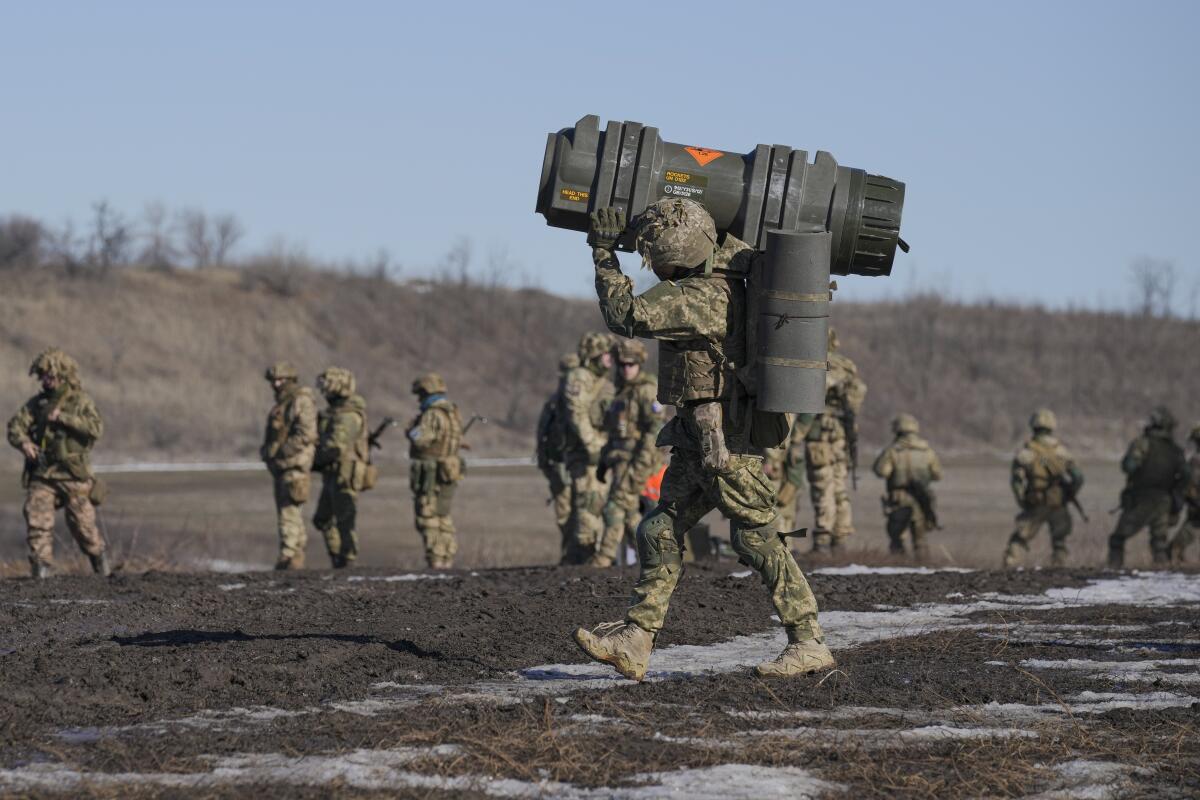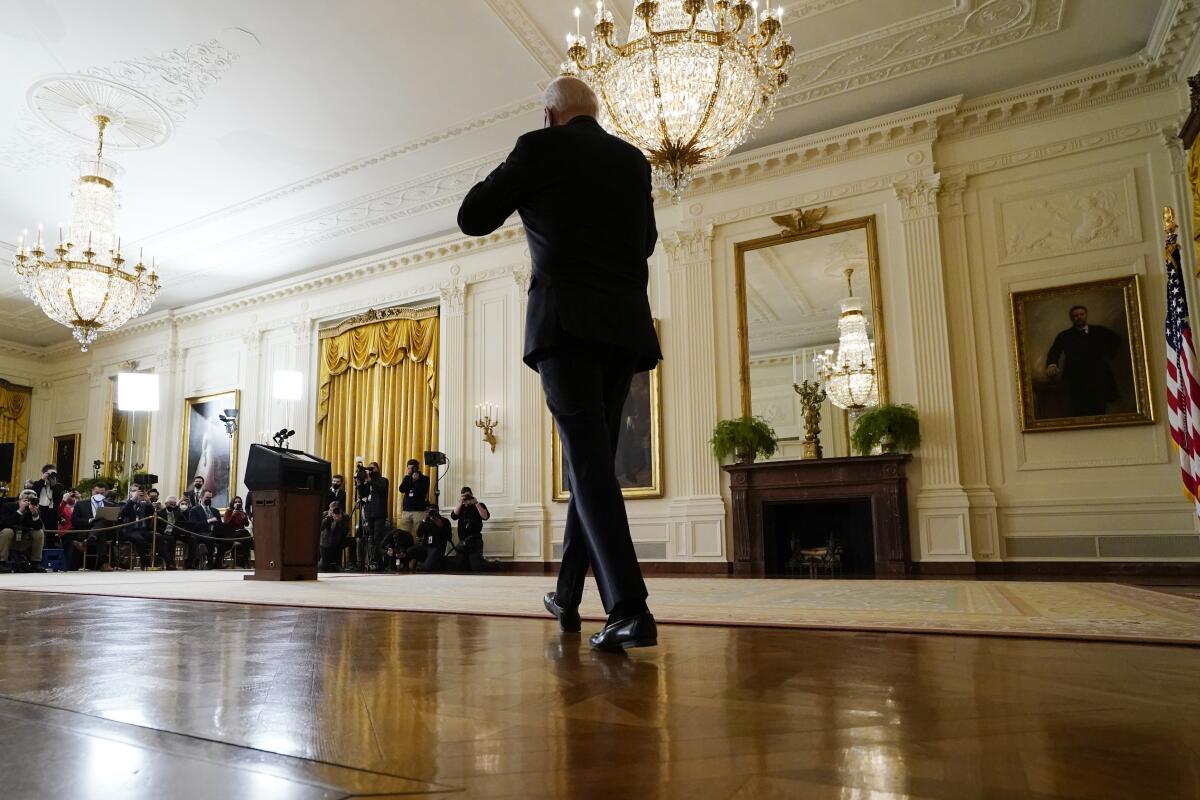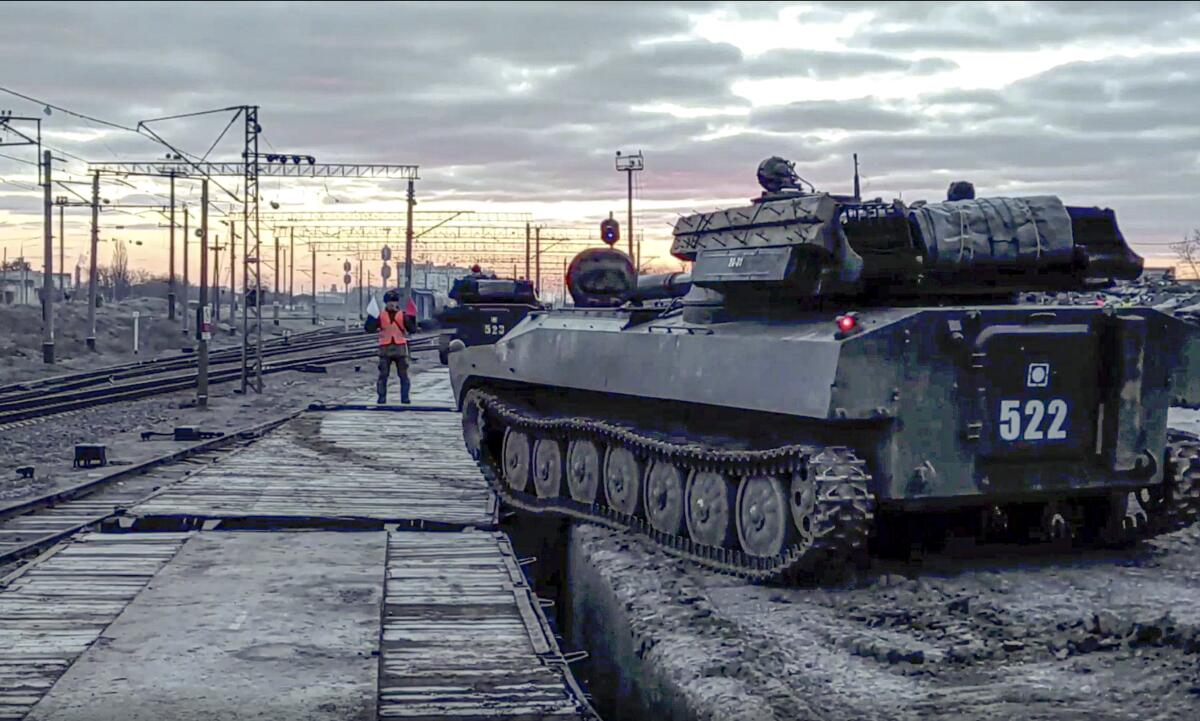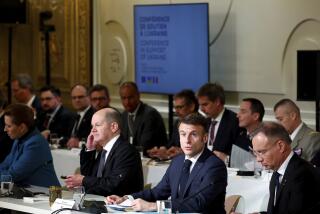Amid Russia’s claims of troop pullback, Biden warns Ukraine invasion ‘distinctly possible’

- Share via
KYIV, Ukraine — Even as Moscow claimed it was withdrawing troops near Ukraine on Tuesday, signaling a possible easing of tensions with the West, President Biden warned that an invasion by Russian forces was “distinctly possible” in a standoff that has ignited concerns over a new and dangerous Cold War.
The Russian Defense Ministry said in a statement that large-scale exercises involving land, sea and air units were ongoing. But as combat training was completed, Maj. Gen. Igor Konashenkov indicated that a number of troops would be returning to their permanent barracks and garrisons.
The move offered a measure of hope that Moscow was pulling back from a full-scale invasion of its neighbor, a former Soviet republic. In recent weeks, Russia has massed more than 130,000 troops that have nearly encircled Ukraine. The deployments have raised alarm in Western governments as U.S. and NATO officials have warned of an imminent attack.

Hours after the Russian announcement, Biden said he wanted to “give the diplomacy every chance,” even as he noted that an invasion was “still very much a possibility.”
“The Russian defense minister reported today that some military units are leaving their positions near Ukraine. That would be good, but we have not yet verified that,” Biden said from the East Room of the White House. “Our analysts indicate that they remain very much in a threatening position.”
Biden also informed Americans that an escalating conflict could have an impact domestically: “I will not pretend this will be painless. There could be impact on our energy prices, so we are taking active steps to alleviate the pressure on our own energy markets.... We’re coordinating with major energy ... consumers and producers.”
The crisis, which has rippled across European capitals, flared up over Russian President Vladimir Putin’s insistence that the North Atlantic Treaty Organization’s expansion eastward is a threat to Moscow. It is unclear what concessions — if any — Putin may have received from European leaders and Biden, but on Monday, Ukrainian President Volodymyr Zelensky acknowledged that NATO membership, despite being written in the country’s constitution, remained a “dream.”
In his statement, Konashenkov said Russian units “of the southern and western military districts, having completed their tasks, have already begun loading onto rail and road transport and will begin moving to their military garrisons today.” Russia’s army divides its command into five districts. The southern and western districts cover territories neighboring Ukraine.

In many ways, the standoff resurrected Cold War animosities and highlighted the mistrust between Washington and Moscow as Putin maneuvered to upset the transatlantic alliance and Biden portrayed the Russian leader as endangering the independent states that emerged from the dissolution of the Soviet Union. The drama was heightened by quicksilver diplomacy involving Kyiv and Moscow, including by French President Emmanuel Macron, who suggested that Europe should possibly rethink its security architecture.
The intrigue surrounding Ukraine — and the prospect of Russia’s ability to cause disruptions beyond military threats — was evident late Tuesday when the Ukrainian Defense Ministry and two of the country’s largest banks were hit by cyberattacks, according to a statement from Ukraine’s Center for Strategic Communications. Moscow did not claim responsibility for the attacks, but Russian hackers for years have upset corporations and countries, including by targeting the U.S. 2016 presidential election.
The Russian Defense Ministry’s troop withdrawal announcement came amid other encouraging signs from the Kremlin. Putin met this week with Russian Foreign Minister Sergei Lavrov and, in a highly choreographed scene, tasked his top diplomat to continue negotiations with the West, which had threatened punishing economic sanctions and other consequences if Russia were to invade Ukraine.
Russia insists that any strategy to include Ukraine in NATO represents an unacceptable challenge to its security. Putin has demanded that NATO deny Ukraine the chance to ever join the military alliance, reverse missile deployments near Russia’s borders and roll back NATO’s military infrastructure to 1997 levels. NATO has described the demands as a nonstarter, and the acrimony is playing out as Europe is at once increasingly suspicious of Moscow but also reliant on its oil and gas.
In a news conference Tuesday after a meeting with German Chancellor Olaf Scholz in Moscow, Putin said that although the U.S. and other NATO members have yet to provide a satisfactory answer to Russia’s demands, there was room to follow the negotiation track.
“Do we want a war or not? Of course not,” said Putin. “That’s why we put forward our proposals for a negotiation process.”
Still, Russia’s statements did not completely dispel fears in Kyiv or among NATO leaders that war is no longer on the table. Konashenkov said that large-scale naval and other military drills were still being conducted. He also did not provide specifics about the number of troops being withdrawn, but an army statement on Tuesday said some of the troops would return to their permanent stations in Dagestan and North Ossetia.
Western and Ukrainian officials viewed such developments with caution. NATO Secretary-General Jens Stoltenberg said: “We have not seen any sign of de-escalation on the ground.”
“What we have seen on the ground, since last spring, is that they are moving forces around,” Stoltenberg told reporters, noting that such movements had not been accompanied by the withdrawal of equipment. “The movement of forces does not represent real de-escalation.”
Ukrainian officials also expressed skepticism about Russia’s intentions: “When we see the withdrawal, we will believe in de-escalation,” said Ukrainian Foreign Minister Dmytro Kuleba during a video briefing from Kyiv on Tuesday.
Such misgivings may be justified. Konrad Muzyka, director of the Poland-based Rochan consultancy, which analyzes open-source materials, said that reports on social media indicated Russia was moving additional equipment to staging areas in Crimea and Belarus.
“A withdrawal will be a very welcome development, but the most recent history of such troop withdrawals tells us that it’s the opposite,” he said in an interview Tuesday. “This isn’t a security-building measure. Quite the contrary; this could be a deception measure.”
Meanwhile, U.S. Defense Secretary Lloyd J. Austin III is set to travel on Wednesday to meet with allies and NATO defense ministers “to discuss Russia’s military buildup in and around Ukraine,” Pentagon Press Secretary John Kirby said in a news briefing. The U.S. in recent weeks has sent more troops to bolster NATO’s eastern flank.
“We still don’t believe that some final decision [by Russia] has been made,” Kirby said. “We have said for a while now that military actions can happen any day.”
Kirby reiterated Biden’s message that in the event of a Russian invasion, the United States, which has said that none of its troops would fight in Ukraine, would respond swiftly with severe economic consequences.
Russian officials claimed that Tuesday’s withdrawal represented a defeat of Western governments’ insistence that an invasion was imminent.
“15 February 2022 will go down in history as the day Western war propaganda failed,” Russian Foreign Ministry spokeswoman Maria Zakharova said on her official channel in the messaging app Telegram. “Humiliated and destroyed without a single shot fired.”
The military maneuvers come amid intensifying concern about deepening rancor between NATO and Russia. Scholz, fresh off a visit to Kyiv, the Ukrainian capital, on Monday, visited Moscow on Tuesday. It was his first meeting with Putin since becoming Germany’s chancellor last year. Officials from Italy, Britain and Poland are set to visit Kyiv this week.
Earlier in the day, Russia’s lower house of parliament — the State Duma — approved a resolution to send Putin a proposal to recognize Donetsk and Luhansk, the two regions in eastern Ukraine held by Russia-backed separatists, as independent republics. The recognition would upend the so-called Minsk agreement, a 2015 deal aimed at returning the two regions to Ukrainian rule while granting them special status.
In the news conference after meeting with Scholz, Putin said that the situation in the regions, which are known informally as the Donbas, was “genocide” but that any solution had to come through applying the Minsk agreement.
Times staff writer Eli Stokols in Washington contributed to this report.
More to Read
Sign up for Essential California
The most important California stories and recommendations in your inbox every morning.
You may occasionally receive promotional content from the Los Angeles Times.











